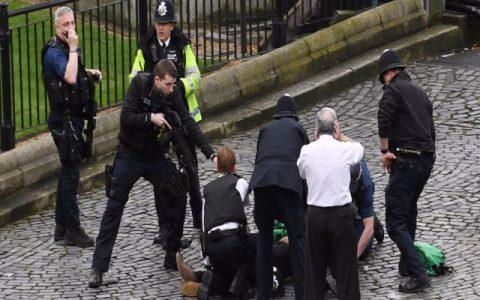
London terrorist attacker is a soldier of the Islamic State terrorist group
The Islamic State’s Amaq News Agency has issued a statement claiming that the terrorist responsible for yesterdays attack in London was a “soldier” of the so-called caliphate.
Citing a security source, Amaq states: “The attacker yesterday in front of the British parliament in London was a soldier of the Islamic State, executing the operation in response to calls to target citizens of coalition nations.”
Amaq’s claim is similar to a series of statements that were issued after past operations across Europe and the US.
Thus far, Amaq hasn’t provided any specific details about the man responsible for killing at least three people, including an American citizen and a British policeman, and wounding dozens of others. The terrorist drove his vehicle into a crowd, then jumped out and used a blade to assault other people.
The UK Metropolitan Police has identified the terrorist as Khalid Masood, a 52 year-old man who was born in Kent and is believed to have been most recently living in the West Midlands. Masood was known by a number of aliases,but was not the subject of any current investigations and there was no prior intelligence about his intent to mount a terrorist attack.
However, the Metropolitan Police says Masood was known to police and has a range of previous convictions for assaults and other crimes. His criminal record extends all the way back to November 1983 and his last conviction was in December 2003 for possession of a knife.
Abu Bakr al Baghdadi’s propagandists have repeatedly encouraged followers to ram their vehicles into Western citizens. Al Qaeda in the Arabian Peninsula (AQAP) has also promoted the idea.
Last year, jihadists used trucks during attacks in Nice on Bastille Day and at a Christmas market in Berlin. In both cases, Amaq described the attackers as a “soldier” of the caliphate.
Another similar assault was carried out at Ohio State University in November, when a Somali refugee, Abdul Razak Ali Artan, drove his car into a crowd of people before exiting the vehicle and then using a knife to assault his victims. Artan was quickly shot dead by a campus police officer. Once again, Amaq described him as the Islamic State’s soldier.
In addition to the instances mentioned above, Amaq and other Islamic State propaganda outlets frequently describe the terrorists who carry out such deeds as “soldiers” of the caliphate.
An Islamic State claim of responsibility doesn’t prove that the group had direct ties to the attacker. However, authorities have found that terrorists had digital ties, or were at least inspired by the Islamic State, in a number of cases. Islamic State operatives have also orchestrated a series of plots in the West.
For example, the Islamic State described the May 2015 shooters in Garland, Tex. and the couple who assaulted a holiday party in San Bernardino, Calif. as the group’s “soldiers.” The San Bernardino terrorists were also labeled “supporters.”
The shooters in Garland, Tex. reportedly communicated with Junaid Hussain, a key Islamic State operative who was killed in an American airstrike last year. And the husband and wife jihadists responsible for the massacre in San Bernardino pledged their allegiance to Abu Bakr al Baghdadi on Facebook prior to their demise.
The team of jihadists that carried out the Nov. 2015 assault in Paris was hailed as “a group of believers from the soldiers of the Caliphate.” In that case, the jihadists were directly dispatched by the Islamic State’s mother organization in Syria. The Paris attacks were different from the other, small-scale attacks claimed by the Islamic State and carried out by individuals in Europe.
Omar Mateen, who repeatedly pledged allegiance to Abu Bakr al Baghdadi the night of his shooting at an LGBT nightclub in Orlando, Fl. in June, was described as a “fighter” for the organization.
Amaq said Mohamed Lahouaiej Bouhlel, who drove a truck into a crowd celebrating Bastille Day in Nice, France, was a soldier of the Islamic State. The same wording was also used to label a young slasher in Würzburg, Germany.
After the Nice, Würzburg, Ansbach (Germany) and Saint-Etienne-du-Rouvray (Normandy, France) attacks, Amaq also emphasized that the men responsible had acted in response to calls to target countries belonging to the crusader coalition.
And after the operations in Würzburg, Ansbach, Saint-Etienne-du-Rouvray and Balashikha (Russia), Amaq disseminated videos of the terrorists swearing allegiance to Baghdadi. The videos were recorded beforehand, demonstrating that the jihadists had at least some digital ties to the Islamic State’s operations.
Indeed, European officials discovered that a series of plots have been remote-controlled by the Islamic State’s digital operatives. American authorities have also found that the so-called caliphate’s men had virtual connections to a number of recruits who were intercepted before they could carry out their murderous acts.
Source: /Long War Journal







You must be logged in to post a comment.